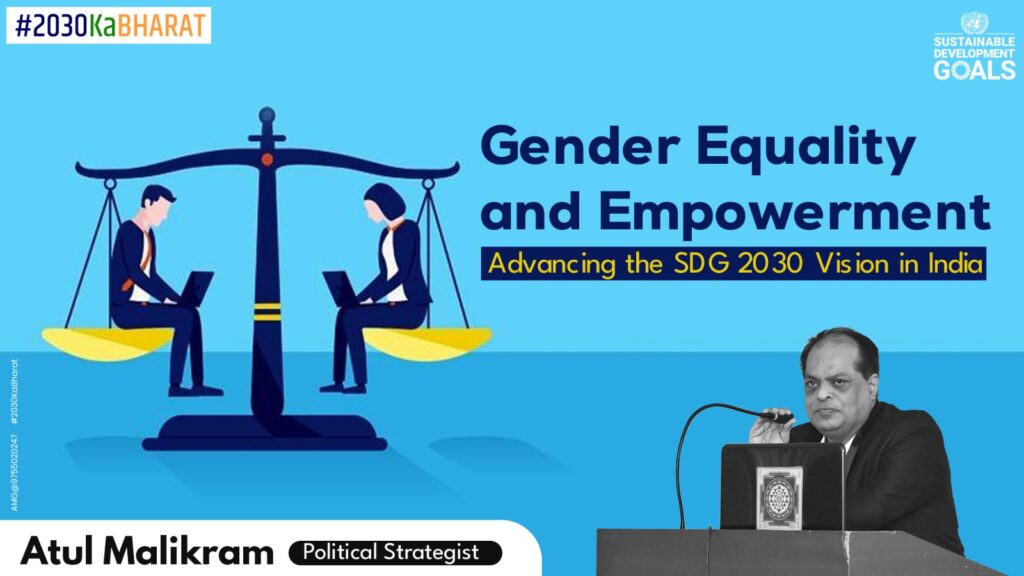In our pursuit of advancing the Sustainable Development Goals (SDGs) for the year 2030, India stands at the forefront, taking monumental strides towards achieving gender equality and empowerment. These efforts are vital not only for India but also for the global community, as gender equality is not just a goal in itself but a catalyst for achieving other development objectives. This article delves into India’s journey towards gender equality and empowerment, highlighting the progress made, the challenges faced, and the roadmap to the SDG 2030 vision.
Setting the Stage: The Significance of SDGs
Sustainable Development Goals, also known as the SDGs, are a universal call to action to end poverty, protect the planet, and ensure prosperity for all by 2030. Among the 17 SDGs, Goal 5, focused on achieving gender equality and empowering all women and girls, holds a pivotal place. It recognizes that gender equality is not only a fundamental human right but a necessary foundation for a peaceful, prosperous, and sustainable world.
India’s Commitment to Gender Equality
India, as a signatory to the SDGs, has demonstrated unwavering commitment to achieving gender equality and empowerment. The government has adopted a multi-faceted approach, recognizing that gender equality is not an isolated issue but interlinked with several other SDGs.
Empowering Women Economically
One of the key facets of India’s approach is the economic empowerment of women. Programs like “Beti Bachao, Beti Padhao” and “MUDRA Yojana” have been instrumental in encouraging women’s entrepreneurship, financial inclusion, and self-reliance. These initiatives have not only improved the socio-economic status of women but also contributed to the larger goal of reducing poverty.
Promoting Education for All
Education is a powerful tool for empowering women. India has initiated schemes like “Sarva Shiksha Abhiyan” to ensure universal access to quality education. Additionally, the “Ujjwala Yojana” has provided LPG connections to rural households, reducing the burden on women who traditionally gathered firewood, thereby enabling them to focus on education and economic activities.
Legal Reforms and Safety Measures
India has also taken significant steps in legal reforms and safety measures. The “Nirbhaya Fund” was established to support initiatives aimed at enhancing the safety and security of women. Moreover, stringent laws have been enacted to combat crimes against women, sending a strong message that gender-based violence will not be tolerated.
Challenges on the Path to Gender Equality
Despite remarkable progress, India faces several challenges on the path to gender equality and empowerment. These challenges are complex and deeply rooted in societal norms and historical structures.
Gender Stereotypes
Gender stereotypes persist in India, affecting not only women but also men. The belief that certain roles and responsibilities are exclusive to one gender limits the potential of individuals. Overcoming these stereotypes is a significant challenge.
Gender-Based Violence
Gender-based violence remains a critical issue. While legal reforms have been enacted, changing attitudes and behaviors is an ongoing process. Building a culture of respect and zero tolerance for violence is imperative.
Economic Disparities
Economic disparities, particularly in rural areas, still hinder progress. Access to education and economic opportunities for women in remote regions remains a challenge. Bridging this gap is essential for achieving comprehensive gender equality.
The Roadmap to SDG 2030: India’s Vision
India’s vision to advance the SDG 2030 agenda for gender equality and empowerment includes several strategic initiatives.
Increasing Women’s Representation in Decision-Making
Empowering women in decision-making roles is vital. India is actively working to increase the participation of women in politics, administration, and corporate boards. The idea is to provide women with a platform to influence policies and decisions that affect their lives.
Strengthening Awareness and Education
India recognizes the importance of education and awareness. Programs promoting gender sensitization, along with comprehensive sex education in schools, are being implemented to challenge stereotypes and promote gender equality from an early age.
Collaboration and Global Partnerships
Collaboration with global partners, international organizations, and civil society is crucial to advancing the SDG 2030 Goals. Sharing experiences, knowledge, and resources will help accelerate progress towards gender equality and empowerment.
Conclusion: A Collective Effort
India’s journey towards gender equality and empowerment is a testament to the country’s commitment to the SDGs. While challenges exist, India’s multifaceted approach, encompassing economic empowerment, legal reforms, and education, is indicative of its dedication to the cause. The roadmap to SDG Goals highlights the importance of increased women’s representation, awareness, and global collaboration.
Achieving gender equality and empowerment is not an isolated endeavor but a collective effort that involves governments, civil society, and individuals. India’s progress in this direction not only advances the nation but also contributes significantly to the global pursuit of a better, more equitable world.
